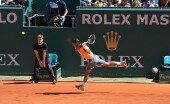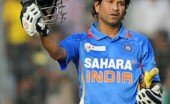‘Purposeful Practice Makes Perfect’
Written by Suhrith // November 6, 2010 // Sport // 3 Comments
Matthew Syed’s book – Bounce: How Champions Are Made – is an interesting even if not an entirely illuminating read. Syed, formerly Britain’s number one table-tennis player and presently a journalist with the Times, argues that ‘purposeful practice,’ and not innate talent, plays the most crucial role in moulding a champion. He relies on examples from a variety of fields, and on Malcolm Gladwell’s Outliers, to conclude upon the 10,000 hour rule: that a person acquires mastery of a skill by practicing purposefully for a period of at least 10,000 hours. Syed uses his own success in table tennis as a case-in-point. He says it was a combination of circumstances – 24-hour access to a table-tennis court, and the presence of a world class coach in his area – and rigorous practice that casted him into a top table-tennis player. How else, according to him, could a small road in Reading have produced a glut of table-tennis champions? – Silverdale Road contained an astonishing number of the nation’s best table tennis players.
Syed cites several instances in an endeavour to establish the superiority of practice over talent, but his argument isn’t particularly novel, even if the evidence adduced may well be considered as its further proof. In a way it’s flattering to think that had I practiced as hard and as purposefully as, say, Sachin Tendulkar did, I may well have perfected the skills that make a champion cricketer. But as compelling as the evidence may be, the romantic in me makes me want to believe in the ‘innate’ gifts that lend a god-like status to some sportsmen.
The book’s core arguments may not be particularly thought-provoking, but Syed provides several other fascinating insights. One such is the role of the Placebo Effect in moulding a sports champion. He cites the examples of triple jump legend Jonathan Edwards, and Muhammad Ali, for whom religion played the part of the Placebo. Edwards, once a devout Christian, when asked if religion played a crucial role in his success, said: “Without doubt. Looking back, I can see that my faith was pivotal to my success… It provided a profound sense of reassurance because I took the view that the result was in God’s hands and that God was on my side. It enabled me to block out doubt in the moments before I was due to jump.” Likewise, Muhammad Ali, who prior to the Rumble-in-the-Jungle bout against George Foreman, a fight that Foreman was favoured to win, said: “How can I lose when Allah is on my side?”
Syed has also sought to dispel any notion of black superiority in running. The abundance of successful Kenyan middle-distance runners, he argues, is a product more of circumstance than genes. He says that a startling majority of the Kenyan runners come from the Nandi district, a small region that is marked by its hilly terrain. High altitude as research has shown is an excellent environment to build endurance. This coupled with the fact that most Kenyan children have to run more than 20 kilometres to reach their school everyday means that they accumulate incredible amounts of practice time before they are sixteen – a phenomenon that Syed argues is directly linked to the superfluity of Kenyan runners.
But, perhaps, the most fascinating aspect of the book is Syed’s views on drugs. He endeavours to find a middle road between prohibition and full scale legalisation. He says that the safety of a drug is determined by the quantity of its administration, in most cases, and that drugs are not by definition safe or unsafe. In most endurance events, the key to success lies in efficient transmission of oxygen to the muscles via the red blood cells. The percentage of red blood cells known as the haematocrit level (HCT) in the body can be enhanced either by injecting EPO – a hormone banned by the World Anti Doping Agency – or by training at high altitude. It is only when the HCT level is elevated above 55 % in the body that risks of a heart-attack increase. When the level stays below 50 % there is no risk, whether it’s achieved by an infusion of EPO or by training at an altitude. It is interesting to note that it is only EPO which is banned, and not training at an altitude. Syed adds that WADA has spent millions of dollars in trying to figure out a foolproof testing model for EPO. Instead he suggests that all blood-altering techniques must be legalised, and that WADA must directly test for HCT, which is a considerably simpler process. Similarly, for steroids, it would make considerable sense in Syed’s opinion to test for the symptoms of over-use as opposed to the mere use of a steroid, ‘which when used moderately can improve strength and aid recovery without causing significant and damaging side effects’.





3 Comments on "‘Purposeful Practice Makes Perfect’"
This vein of books about “deliberate practice” or “purposeful practice” seems to be all the rage of late. Another example along similar lines is Goffrey Colvin’s Talent is Overrated.
By the way, the 10,000 hour rule was formulated neither by Gladwell nor by Syed; it was originally formulated by Anders Ericsson, see Google.
You’re right. In fact Syed refers to both Ericsson, and Colvin’s Talent is Overrated.
I like the helpful information you provide to your articles.
I will bookmark your blog and test once more right here regularly.
I’m somewhat certain I will be informed many new stuff proper here!
Good luck for the following!